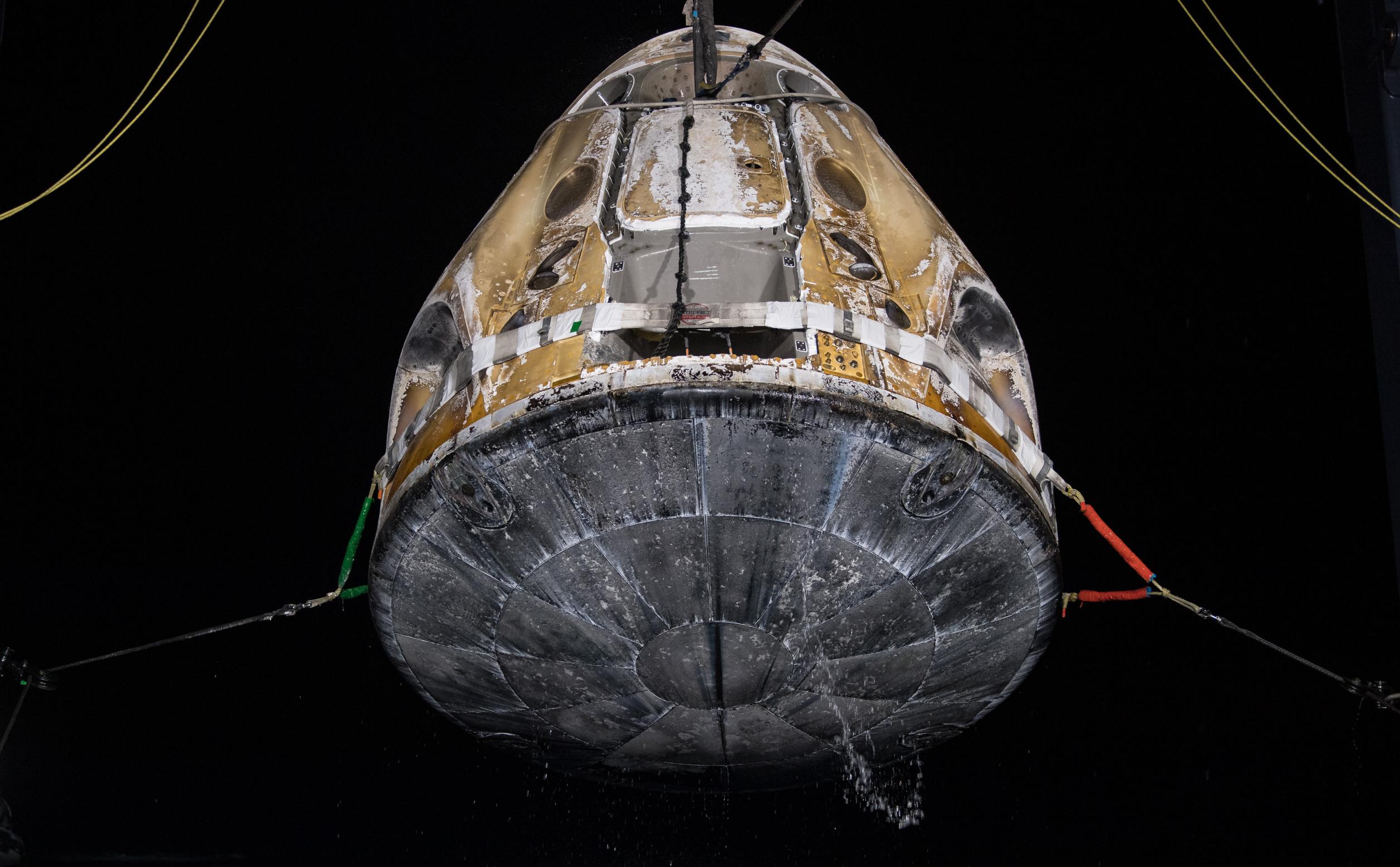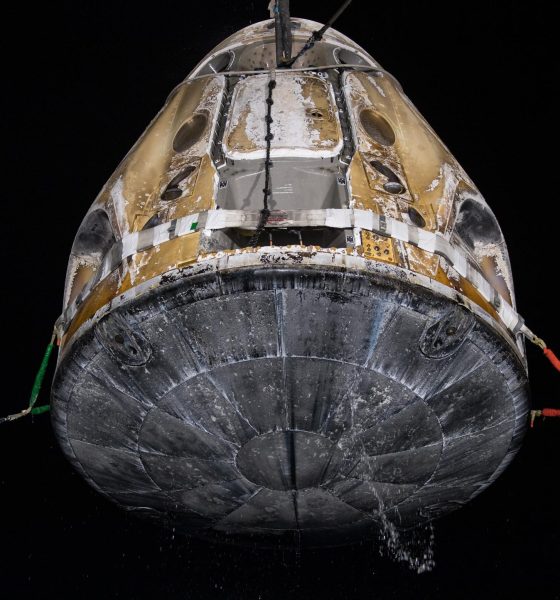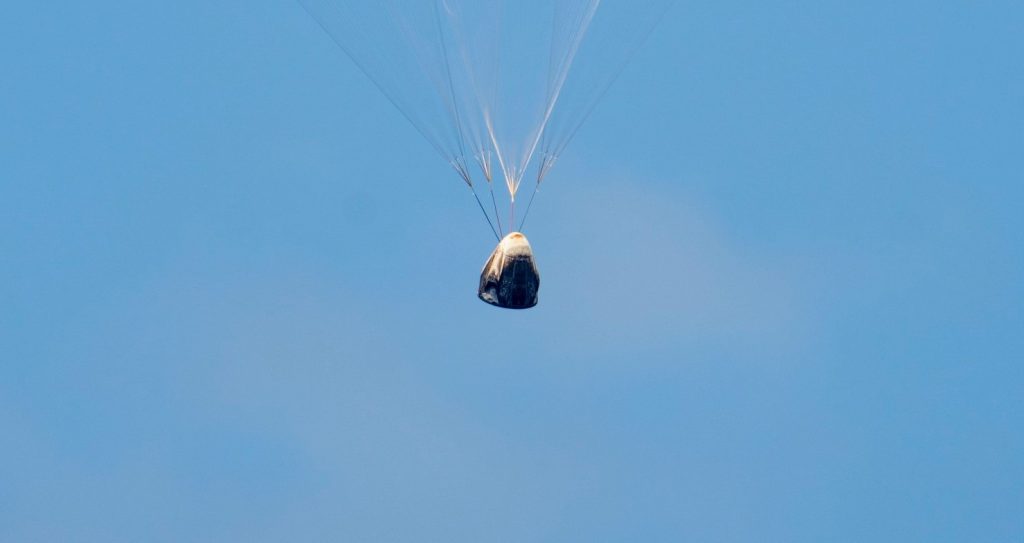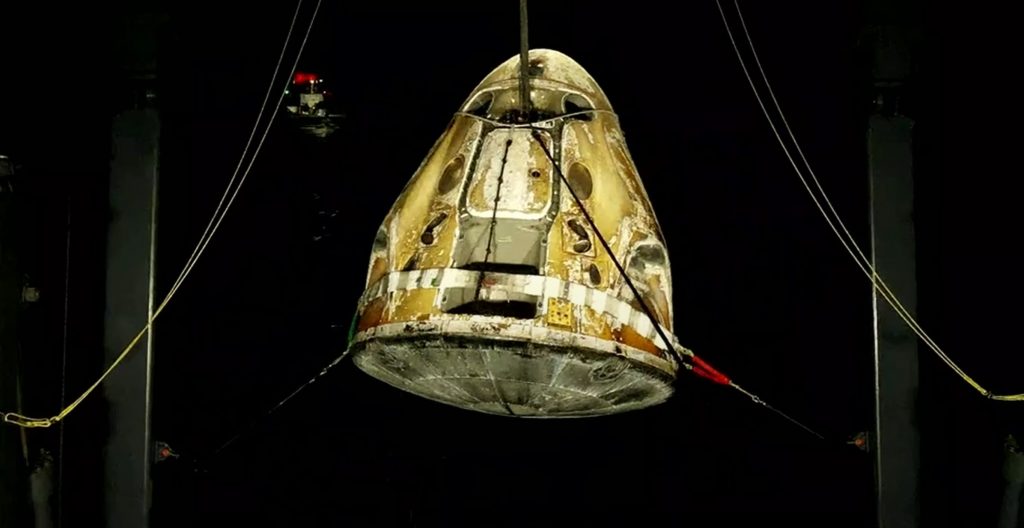

News
NASA denies SpaceX Crew Dragon propellant leak report, reveals unrelated heat shield defect
In a partial response to a report alleging evidence of several significant anomalies during a recent private astronaut launch that could affect a crew of NASA astronauts launched last month, the space agency has issued a statement denying those claims. However, the same statement simultaneously revealed that SpaceX recently discovered a different problem with a different Crew Dragon spacecraft component during ground testing.
On May 23rd, Space Explored published a report alleging that a SpaceX Crew Dragon spacecraft experienced major issues during Axiom-1, the company’s first all-private astronaut launch to the International Space Station (ISS). According to sourced info and a possible internal SpaceX memo, some of Dragon’s toxic propellant leaked during the 17-day flight, damaged or weakened parts of its heat shield, and “[caused] dangerously excessive wear upon reentry.” In general, the report appeared to be well-sourced and even alleged that NASA’s Engineering and Safety Center (NESC) had opened an investigation. Additionally, when approached for comment, neither NASA nor SpaceX were initially willing to speak on the record, which also meant that neither denied the accusations.
A day later, NASA provided an official statement to Space Explored explicitly denying that there has been any propellant leak, heat shield contamination, or excessive heat shield wear on any of “Dragon’s recent crew reentries.”
NASA also dismissed concerns about the reuse of a previously-flown Cargo Dragon 2 heat shield structure on Crew-4, which launched just two days after Axiom-1’s recovery and is scheduled to spend four to five more months in orbit. It also noted that the reuse of Dragon’s heat shield tiles – the structures that take the brunt of most reentry heating and are immersed in salt water after every mission – is extremely limited and has only been attempted on occasional Cargo Dragon missions.
Simultaneously, NASA revealed that “a new heat shield composite structure intended for flight on Crew-5 did not pass an acceptance test” at SpaceX’s Hawthorne, California Dragon factory. The unrelated test failure was blamed on a manufacturing defect and NASA betrayed no sign of serious concern in its statement, suggesting that the problem may be less serious than it sounds. In response, NASA says SpaceX will simply use a different heat shield composite structure for Crew-5, which is scheduled to launch no earlier than (NET) September 2022.
The data associated with Dragon’s recent crew reentries was normal – the system performed as designed without dispute. There has not been a hypergol leak during the return of a crewed Dragon mission nor any contamination with the heat shield causing excessive wear. SpaceX and NASA perform a full engineering review of the heat shield’s thermal protection system following each return, including prior to the launch of the Crew-4 mission currently at the International Space Station. The heat shield composite structure (structure below the tile) was re-flown per normal planning and refurbishment processes. The thermal protection system on the primary heat shield for Crew-4 was new, as it has been for all human spaceflight missions. SpaceX has only demonstrated reuse of selected PICA (Phenolic-Impregnated Carbon Ablator) tiles, which is a lightweight material designed to withstand high temperatures, as part of the heat shield on cargo flights.
NASA and SpaceX are currently in the process of determining hardware allocation for the agency’s upcoming SpaceX Crew-5 mission, including the Dragon heat shield. SpaceX has a rigorous testing process to put every component and system through its paces to ensure safety and reliability. In early May, a new heat shield composite structure intended for flight on Crew-5 did not pass an acceptance test. The test did its job and found a manufacturing defect. NASA and SpaceX will use another heat shield for the flight that will undergo the same rigorous testing prior to flight.
Crew safety remains the top priority for both NASA and SpaceX and we continue to target September 2022 for launch of Crew-5.
NASA – May 24th, 2022
Some oddities do remain. While NASA’s explicit refutation should be taken as the definitive final word on the matter, it’s still very unusual that NASA and SpaceX refused or were unable to quickly and publicly deny the claims within a few hours of being asked. That could simply be a consequence of NASA and SpaceX’s poor internal and external communication or both parties’ love for withholding information from taxpayers about systems and technologies that those same taxpayers have paid for.


On the opposite hand, after Crew Dragon’s Demo-2 run-in with greater-than-expected heat shield wear in 2020, it’s almost impossible to imagine that NASA and SpaceX would have proceeded with Crew-4’s launch two days after Axiom-1’s recovery without confidently verifying that heat shield erosion was within normal bounds. SpaceX’s upgraded Phenolic-Impregnated Carbon Ablator (PICA-X) Dragon heat shield tiles are reportedly designed to erode [PDF] less than a centimeter of their circa-2017 ~7.5 cm (3 in) thickness after each reentry. Musk has gone even further, stating in 2012 that “[PICA-X] can potentially be used hundreds of times for Earth orbit re-entry with only minor degradation each time.” If true, it would be extremely difficult for even a brisk post-flight inspection of Axiom-1’s Dragon capsule to miss what Space Explored described as “dangerously excessive wear.”
In theory, during recovery, even a minute propellant leak should have also been immediately detected by SpaceX’s recovery team, as the very first part of the hands-on process involves a small team with gas masks and detectors approaching the floating capsule to ensure that it’s safe for others to approach. Crew Dragon’s liquid monomethylhydrazine (MMH) fuel and dinitrogen tetroxide (NTO) oxidizer are highly toxic in small quantities and MMH is a known carcinogen.
All told, news of a potential propellant leak and anomalous heat shield performance appears to have been a false alarm, although – coincidentally or not – a seemingly minor anomaly with an unflown Crew Dragon heat shield structure did occur earlier this month. Despite that anomaly, Crew-4 and Crew-5 are otherwise proceeding nominally and NASA appears to be content with Crew Dragon’s performance during several recent launches and recoveries.

Elon Musk
Elon Musk’s X will start using a Tesla-like software update strategy
The initiative seems designed to accelerate updates to the social media platform, while maintaining maximum transparency.

Elon Musk’s social media platform X will adopt a Tesla-esque approach to software updates for its algorithm.
The initiative seems designed to accelerate updates to the social media platform, while maintaining maximum transparency.
X’s updates to its updates
As per Musk in a post on X, the social media company will be making a new algorithm to determine what organic and advertising posts are recommended to users. These updates would then be repeated every four weeks.
“We will make the new 𝕏 algorithm, including all code used to determine what organic and advertising posts are recommended to users, open source in 7 days. This will be repeated every 4 weeks, with comprehensive developer notes, to help you understand what changed,” Musk wrote in his post.
The initiative somewhat mirrors Tesla’s over-the-air update model, where vehicle software is regularly refined and pushed to users with detailed release notes. This should allow users to better understand the details of X’s every update and foster a healthy feedback loop for the social media platform.
xAI and X
X, formerly Twitter, has been acquired by Elon Musk’s artificial intelligence startup, xAI last year. Since then, xAI has seen a rapid rise in valuation. Following the company’s the company’s upsized $20 billion Series E funding round, estimates now suggest that xAI is worth tens about $230 to $235 billion. That’s several times larger than Tesla when Elon Musk received his controversial 2018 CEO Performance Award.
As per xAI, the Series E funding round attracted a diverse group of investors, including Valor Equity Partners, Stepstone Group, Fidelity Management & Research Company, Qatar Investment Authority, MGX, and Baron Capital Group, among others. Strategic partners NVIDIA and Cisco Investments also continued support for building the world’s largest GPU clusters.
News
Tesla FSD Supervised wins MotorTrend’s Best Driver Assistance Award
The decision marks a notable reversal for the publication from prior years, with judges citing major real-world improvements that pushed Tesla’s latest FSD software ahead of every competing ADAS system.

Tesla’s Full Self-Driving (Supervised) system has been named the best driver-assistance technology on the market, earning top honors at the 2026 MotorTrend Best Tech Awards.
The decision marks a notable reversal for the publication from prior years, with judges citing major real-world improvements that pushed Tesla’s latest FSD software ahead of every competing ADAS system. And it wasn’t even close.
MotorTrend reverses course
MotorTrend awarded Tesla FSD (Supervised) its 2026 Best Tech Driver Assistance title after extensive testing of the latest v14 software. The publication acknowledged that it had previously criticized earlier versions of FSD for erratic behavior and near-miss incidents, ultimately favoring rivals such as GM’s Super Cruise in earlier evaluations.
According to MotorTrend, the newest iteration of FSD resolved many of those shortcomings. Testers said v14 showed far smoother behavior in complex urban scenarios, including unprotected left turns, traffic circles, emergency vehicles, and dense city streets. While the system still requires constant driver supervision, judges concluded that no other advanced driver-assistance system currently matches its breadth of capability.
Unlike rival systems that rely on combinations of cameras, radar, lidar, and mapped highways, Tesla’s FSD operates using a camera-only approach and is capable of driving on city streets, rural roads, and freeways. MotorTrend stated that pure utility, the ability to handle nearly all road types, ultimately separated FSD from competitors like Ford BlueCruise, GM Super Cruise, and BMW’s Highway Assistant.
High cost and high capability
MotorTrend also addressed FSD’s pricing, which remains significantly higher than rival systems. Tesla currently charges $8,000 for a one-time purchase or $99 per month for a subscription, compared with far lower upfront and subscription costs from other automakers. The publication noted that the premium is justified given FSD’s unmatched scope and continuous software evolution.
Safety remained a central focus of the evaluation. While testers reported collision-free operation over thousands of miles, they noted ongoing concerns around FSD’s configurable driving modes, including options that allow aggressive driving and speeds beyond posted limits. MotorTrend emphasized that, like all Level 2 systems, FSD still depends on a fully attentive human driver at all times.
Despite those caveats, the publication concluded that Tesla’s rapid software progress fundamentally reshaped the competitive landscape. For drivers seeking the most capable hands-on driver-assistance system available today, MotorTrend concluded Tesla FSD (Supervised) now stands alone at the top.
News
Elon Musk’s Grokipedia surges to 5.6M articles, almost 79% of English Wikipedia
The explosive growth marks a major milestone for the AI-powered online encyclopedia, which was launched by Elon Musk’s xAI just months ago.

Elon Musk’s Grokipedia has grown to an impressive 5,615,201 articles as of today, closing in on 79% of the English Wikipedia’s current total of 7,119,376 articles.
The explosive growth marks a major milestone for the AI-powered online encyclopedia, which was launched by Elon Musk’s xAI just months ago. Needless to say, it would only be a matter of time before Grokipedia exceeds English Wikipedia in sheer volume.
Grokipedia’s rapid growth
xAI’s vision for Grokipedia emphasizes neutrality, while Grok’s reasoning capabilities allow for fast drafting and fact-checking. When Elon Musk announced the initiative in late September 2025, he noted that Grokipedia would be an improvement to Wikipedia because it would be designed to avoid bias.
At the time, Musk noted that Grokipedia “is a necessary step towards the xAI goal of understanding the Universe.”
Grokipedia was launched in late October, and while xAI was careful to list it only as Version 0.1 at the time, the online encyclopedia immediately earned praise. Wikipedia co-founder Larry Sanger highlighted the project’s innovative approach, noting how it leverages AI to fill knowledge gaps and enable rapid updates. Netizens also observed how Grokipedia tends to present articles in a more objective manner compared to Wikipedia, which is edited by humans.
Elon Musk’s ambitious plans
With 5,615,201 total articles, Grokipedia has now grown to almost 79% of English Wikipedia’s article base. This is incredibly quick, though Grokipedia remains text-only for now. xAI, for its part, has now updated the online encyclopedia’s iteration to v0.2.
Elon Musk has shared bold ideas for Grokipedia, including sending a record of the entire knowledge base to space as part of xAI’s mission to preserve and expand human understanding. At some point, Musk stated that Grokipedia will be renamed to Encyclopedia Galactica, and it will be sent to the cosmos.
“When Grokipedia is good enough (long way to go), we will change the name to Encyclopedia Galactica. It will be an open source distillation of all knowledge, including audio, images and video. Join xAI to help build the sci-fi version of the Library of Alexandria!” Musk wrote, adding in a later post that “Copies will be etched in stone and sent to the Moon, Mars and beyond. This time, it will not be lost.”








